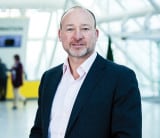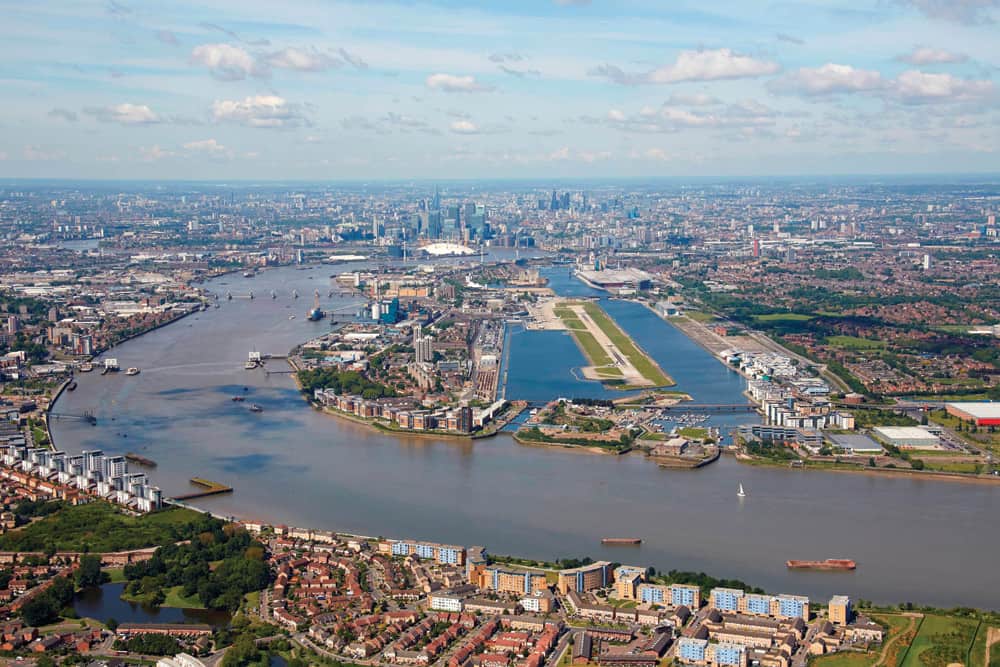Ariel view of the Royal Docks
With a major new regeneration process occurring in the region, the East End of London looks set to become one of the UK capital’s key economic hubs, writes Dean Van Nguyen.
In preparation to host the Olympic Games in 2012, East London underwent a huge amount of regeneration with £9bn spent transforming the district of Stratford from one of the city’s most deprived areas into a modern epicentre that befit the occasion.
The fortnight of sport — plus the Paralympics that followed — lit up the region, but rather than the Games’ closing ceremony signalling the end of the transformation, it was only the beginning.
The UK government’s plans to create a lasting legacy from the Games were drawn up to ensure there was no repeat of mistakes made by previous Olympic host cities, where beautiful new infrastructure were left to decay once the final race was ran. The primary site, which includes the Olympic Stadium and various other facilities, is currently being transformed into the Queen Elizabeth Olympic Park, where new residential homes, business sites, cultural venues and other attractions will open over the coming decade.
But Stratford is just one area of London’s famous East End currently undergoing a renaissance.
The wider borough of Newham and London’s famous Royal Docks will also experience significant investment to create a prominent economic hub that, when completed, is likely to become the city’s third main business district alongside The City of London and the east’s currently established financial centre, Canary Wharf.
“Arguably this is one of the last great regenerating opportunities that London has,” says Jeremy Probert, director of Corporate Communications at London City Airport. Located on a former Royal Docks site, the airport’s presence is widely cited as a factor in turning the area into an attractive proposition to conduct business. “We’re very clearly proud to be a part of driving it,” he says.
Olympic spirit

David Pegler, CEO, ExCel London
While the Olympic Park itself is just one area currently undergoing regeneration, the knock-on effect of London’s successful Olympic bid can’t be underestimated when considering the long-term renaissance of the East End.
“The Games were incredibly important, not least of all because we had a fabulous couple of weeks where London was beamed into billions of rooms all around the world,” says David Pegler, CEO of ExCel London, a 100,000 sq.m. international exhibition and convention centre located in Royal Victoria Dock. “I think the great thing Londoners must get credit for, is that they always said from the outset that 2012 was the start not the end. So we were actually all aligned to make sure we took advantage of the opportunity the Games gave us as a city and as a country.
“We’re winning lots of business that we had identified before the Games and there really is an Olympic bounce that has probably got, if invested in properly, 20 years of opportunity for us to develop the rest of our city.”
ExCel hosted several Olympic events including boxing, judo and table tennis and was the only building that was a part of the 2003 bid application that had actually already been built. Opened in 2000, it predates much of the development in the Royal Docks and has played an important role in bringing traffic into the region. In 2013 alone, the venue welcomed 3.5 million visitors.
“We ended up being on site in the 1990s when the whole area was derelict and the venue was opened in 2000. So we were the first beacon for the opportunity and what could be achieved in the area,” asserts Pegler.
Royal Docks
The Royal Docks were once vital to London’s economy. Made up of the Royal Victoria, Royal Albert and King George V docks, they were the city’s principal harbours during the first half of the 20th century before falling into decline in the 60s and eventually closing in 1981.
With many of the sites lying derelict ever since, Mayor of London, Boris Johnson, has prioritised working with private sector partners to develop the area. The docks are now being touted as a centre for global trade that will deliver thousands of jobs in the future.
Development in the area includes ABP (Asian Business Park) on the Royal Albert Dock, a £6bn, 4.7 million sq.ft complex that will aim to provide trade links between Asia and Europe. ABP hope to attract established financial institutions from both continents, as well as tech firms, creative businesses and companies working in retail and production.
Elsewhere, the Silvertown Quays, on the south side of the Royal Victoria Dock, are to be transformed into a vibrant new destination of housing, restaurants, commercial buildings and retail outlets.
According to Olaide Oboh, sales and marketing manager with First Base, a development and investment firm who form part of The Silvertown Partnership consortium, the regeneration process will not just transform abandoned locations, but the wider East London area. “East London, as a location, is crying out for jobs,” affirms Oboh. “It’s a location that has a lot of unemployment, particularly youth unemployment. Young people are coming into the jobs market at the moment and there are no jobs for them in that area. A lot of people under 25 —or 25 to 35 — are in East London. So this area needs something that is going to provide an economic boost. Not just housing — we are in need of housing — but importantly we’re in need of jobs.”
London City Airport’s modern terminal
Transport
One of the most important aspects facilitating the revival of East London has been improvements to the transport system.
Servicing the area is the Docklands Light Railway (DLR), a train line that connects the Docklands to the London Underground and, therefore, the rest of the city.
Originally opened in 1987, the DLR has undergone several extensions and enhancements since. In addition, Crossrail, a new line that will provide an easy east-west route across Greater London, is currently under construction. Crossrail is expected to be an important enabler for the Royal Docks, allowing travellers to make it to and from Central London in less than 15 minutes.
First Base’s Olaide Oboh even goes as far describe the undertaking as “the biggest driver for us getting interested in [The Silvertown] project”.
This sentiment is echoed by London City Airport’s Jeremy Probert: “The DLR serves us well and obviously allows easy access to and from this part of town. But it doesn’t stop there. Clearly we’ve got Crossrail as well, the major cross London rail project while will be opening in 2018 and the airport is currently lobbying — or at least certainly opening discussion — about bringing a cross section to the airport and to the community the airport serves. Obviously it allows greater ease to get people to the airport, but it also provided the facility for the community around the airport.”
Future development
Many of the planned developments remain in the early stages with shovels yet to hit the Dockland’s dirt. The majority of the Olympic Park, however, has reopened to the public. Silvertown says that sections of the new district will be ready for occupation at the end of 2017, while Phase 1 of APB is scheduled for completion in 2018.
Coupled with the Crossrail becoming fully operational in 2018 and the already fully-functioning London City Airport, this newly stimulated area of East London looks likely to become a centre of economic importance for decades to come.

